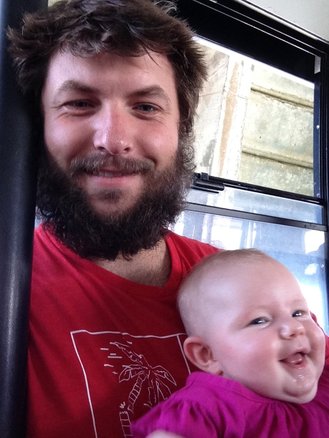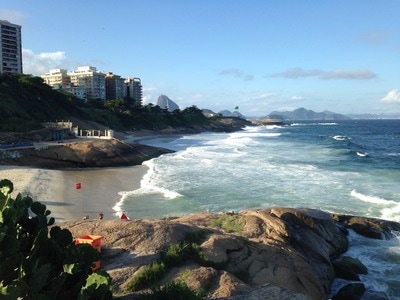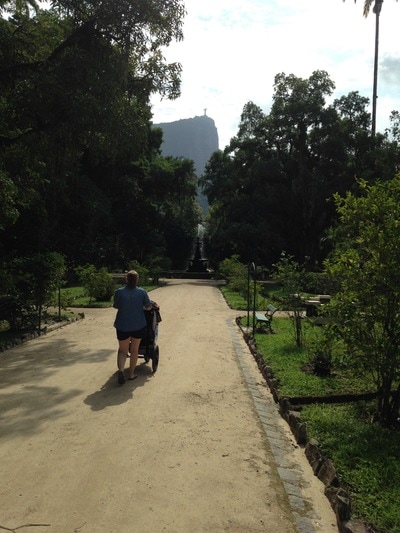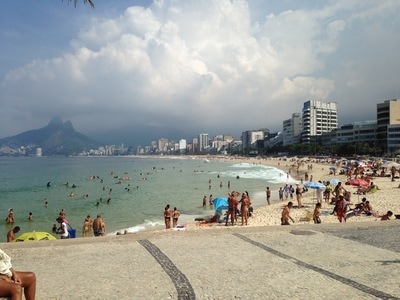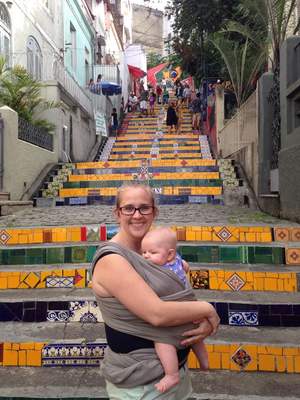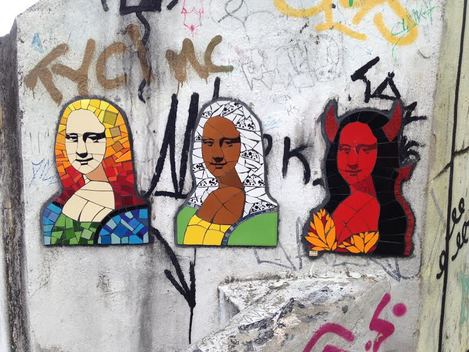|
When I arrived in South America, of all the sights I wanted to see and exotic locales I hoped to wander, only a single city earned a spot on my “Must-Visit” list: Rio de Janeiro. We’ve lived in Paraguay for three years and, until now, other South American travel-priorities always superseded a visit to the Brazilian city of sand and samba. And with good reason. Machu Picchu, Patagonia, Uyuni, the Amazon and the Andes of Northern Argentina (among others) are tough competitors. We’ve focused most our vacation-time on outdoor pursuits and have hiked and camped a lot during our travels. Then we had Alanna, our beautiful baby girl. As I have now learned, travel plans change rather drastically when you have an infant. Carrying a tent and your own gear on your back as you hike around a canyon or coastline is feasible. Carrying a tent, your gear, a bazillion diapers, wet-wipes, butt-cream, clothes, cute little hats, teething toys, sleepers, a stroller, breast-feeding pillow, spit-up cloths, baby shampoo, blankets, and the baby itself increases the difficulty-level slightly! For our first excursion outside of Asunción with Alanna, we quickly decided on Rio. It was a modern city, which implied a smorgasbord of pharmacies selling diapers, wipes, butt-cream, baby-medicine and any other necessities that might arise suddenly. A quick Google-Images search revealed that Rio has relatively well-maintained sidewalks – something we've learned never to take for granted. Rio has beaches - we love oceans. Rio boasted a variety of food and craft beer – we conveniently enjoy both. Also, for Danielle, Starbucks. It was decided. After two visits to the Brazilian embassy to apply for and acquire our visas, we hopped on a few planes and embarked on our first travelling adventure with our chubby-cheeked daughter. I don’t want to bore you with the specifics of our baby-centred daily itinerary in Rio de Janeiro, so I’ve boiled down our baby-travel experience of traveling in Rio with a four-month old daughter into four observations: 1) I know that our week-long experience in Rio does not enable us to make a definitive statement regarding Brazilian attitudes towards children. However, I’m going to make one anyway: Brazilians seem to love babies. Even more than the average person loves babies. No, seriously; they really love babies. Alanna’s drooling, droopy jowls were a magnet for cheerful commentary from smiling cariocas. The first phrase I learned in Portuguese was “Ela tem bochechas enormes,” or “she has enormous cheeks.” Alanna’s cheeks were pinched and fondled endlessly by random strangers ogling her “bochechas;” she basked in the attention by smiling coyly and then turning away in a vain effort to appear uninterested in the newfound attention. Having a baby in tow was also a magnet for kindness. Shoppers held doors for our stroller. Our Airbnb host playfully carted Alanna up four flights of stairs while we dealt with our bags. Taxi drivers stalled traffic by waving us across the street. Passerby’s helped pack our monster-stroller into Uber vehicles. While changing a (particularly gnarly) diaper on a Copacabana bench, a street-vender snatched her dirty diaper from the ground, folded it up neatly, and disposed of it in a rubbish bin before returning for a rewarding smile from Alanna. I could go on. In short, we were overwhelmed by the kindness we received throughout our week-long visit to Brazil’s star-city. 2) Our Airbnb was right on Ipanema beach, so a few hours of each day were spent strolling along the iconic wave-patterned cobblestone of Copacabana, Leblon and Ipanema. On these daily excursions, we tucked Alanna comfortably into her stroller, lathered sunscreen on her legs, wrestled a hat onto her balloon-head and picked our way through the joggers, cyclists, surfers, sun-tanners, beggars, vendors, police, artists, and tourists who swarm the beaches. It was relaxing to walk, chat and observe the incessant parade of humanity with the sounds of pounding waves and honking horns as a backdrop. Alanna clearly demonstrated the ocean-going nature of her parentage by falling asleep almost every time we left the Airbnb to the rhythmic song of the ocean. It was great. 3) Dragging a baby around amplifies the difficulty in taking quality photographs of our travels. This lesson was best-exemplified by our experience at the Cristo Redentor, the Brazilian behemoth Jesus-statue overlooking the city that was selected as one of the Seven Modern Wonders of the World. The throngs of maniacal, camera-wielding tourists made it difficult to navigate our stroller, let alone watch our bags, pose and snap photos from odd angles. When Alanna started fussing to boot, we basically gave up, gave the outstretched stone arms a final glance and took off to calm an impending scream-storm. In previous travel-escapades, I could take my time and try to capture quality pictures. Now that we have our gorgeous gordita in tow, getting the right shot is subservient to the whims of my daughter’s attention span and ever-changing mood. On the bright side, pictures of myself have been generally improved by the beatifying presence of my daughter. 4) Travel-dining with an infant is a radical break from our pre-baby habits. We found ourselves searching for food that would be easy and quick rather than finding Brazilian fare. Leisurely conversation over food and drinks has come to a temporary halt; when we settled into our seats for a meal, we understood that we had a ticking time-bomb in our possession that would inevitably “explode” by loudly demanding a feeding, a bum-change or a change in scenery. The unintended result of this knowledge was that we ate in restaurants less and relied even more heavily on supermarkets than normal. Our first journey with Alanna was a learning experience. We didn’t do or see as much as we likely would have in our pre-baby days. It was well-worth it though. Our experience of Rio de Janeiro was enriched by sharing it with her. I wouldn’t trade the addition of her smiles, globs of drool, cuddles and wide-eyed wonder to our travels for anything! Rio de Janeiro will stand out in our memories not for the beaches, the food, the views or the friendly carioca vibe; will be memorable because it was our first big adventure as a little family.
And I’ll always remember the meaning of “bochechas enormes”!
0 Comments
The highlight of Rio de Janeiro, for me at least, was not walking the iconic beaches of Copacabana, Leblon and Ipanema, the stunning views from the Sugarloaf cable car, the Christ Redeemer statue or the wonderful, but admittedly expensive, craft-beer. It was a set of stairs. The Escadaria Selarón is the handiwork of Chilean artist Jorge Selarón, who lived in the hill-side community of Santa Teresa from 1983 to his death in 2013. In 1990, he began to renovate a set of dilapidated steps near his home on a whim using broken tiles and hand-painted bathtub porcelain lifted from construction sites and broken mirrors scavenged from landfills. Upon the completion of his original venture, Selarón set his gaze on beautifying another staircase a few feet away. His side-project soon blossomed into a lifetime obsession; he dedicated twenty-three years of his life to what became his magnum-opus. Initially Selarón funded his project by selling paintings of an enigmatic pregnant African woman but, as word of his art spread, he began receiving donations of hand-painted tiles from around the globe. Over the years, the steps spidered across the community, incorporating thousands of colourful tiles from dozens of countries on every continent, all carefully mortared into the stairs by Selarón himself. He dedicated his work to the people of Rio de Janeiro and viewed the stairs as a living work of art stating that his labour of love would only “end on the day of my death.” Selarón’s labours ended early on the morning of January 10, 2013 when his body was found soaked in paint thinner and burned at the foot of the staircase. Selarón literally lived, worked and died surrounded by his art. We visited Santa Teresa and the Escadaria Selarón on our final day in Rio after almost deciding to skip it in favour of a beach-day. The minute we hopped out of the taxi (well…as much as you can hop out of a taxi when an infant is involved) we instantly knew we’d made the right decision. The kaleidoscope of colours and textures combined with the killer views from the top was mesmerizing. We spent several hours participating in what was essentially a scavenger hunt on an obstacle course - hunting for tiles while politely attempting to avoid photo-bombing other tourist’s pictures. Donated tiles displayed scenes from a multiplicity of landscapes and countries, from Switzerland to Swaziland, Australia to Albania, Canada to Costa Rica - if you can think of a country, you’d probably be able to find a tile from there if you searched hard enough! While we scoured the staircase, I couldn’t help but be awed and inspired by Selarón’s dedication to his craft. The immeasurable amounts of time, energy and sweat required to construct and constantly reinvent such an intricate, functional and unique piece of art was humbling and thought-provoking. I was reminded of the architects, stone-masons and carvers of the Middle Ages who devoted their entire lives to constructing a single cathedral knowing that they would likely die before its completion. There is something incredibly noble and honourable about such endeavours. I can hardly imagine being so invested in a single project that I would literally dedicate my life to it - I have enough trouble dedicating myself adequately to a five day work-week!
In some ways, Selarón’s staircase is the carioca equivalent of those cavernous cathedrals of Christianity. While Europe’s churches are somberly dedicated to the worship of God, the Escadaria Selarón was described by Selarón as a “tribute to the Brazilian people.” While cathedrals were designed encourage awe-filled worship by naturally raising heads of the congregation to intricately carved ceilings and stained-glass arches, Selarón’s masterpiece celebrates the diversity, playfulness, and beauty of the city and people of Rio de Janeiro with a riot of colours. When we departed the next day and the plane ascended over the jumbled metropolis of Rio de Janeiro, it wasn’t the beaches, views or food that I knew I would remember – it was those stairs. For me at least, Jorge Selarón had left his mark. |



